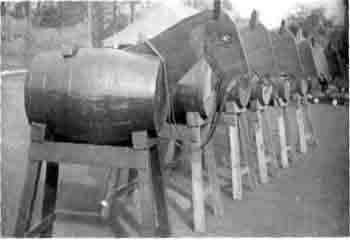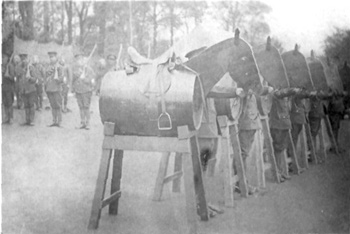The following article titled “Wooden Horses for Training Recruits” is a reprint from the July-September 1917 Field Artillery Journal. Perhaps one of US Horsemanship’s readers if the U.S. Army actually utilized this idea. I find the theory behind the suggestion interesting, as it is not so far from the mechanical horses that are in use today.
Thanks for joining me on USHorsemanship.
Barbara Fox

Wooden Horses for Training Recruits
WITH a million men to train at once and little or no equipment in many cases with which to make a suitable beginning, the United States will, for months to come, be taxed to its utmost to find suitable extemporized schemes which will permit the most to be made of these early months of preparation. From abroad we can well afford to take a few hints, and particularly from a country that was caught unprepared, with a relatively small army and dependent upon voluntary enlistments when this great war began, since the situation was very much like our own in some respects.
Col. C. P. Summerall, of the United States Field Artillery, who recently returned from a trip of observation in England and France, presented to the JOURNAL for publication the photographs which appear in connection with this article, and gave this explanatory statement:
“Wooden horses, constructed as indicated by the accompanying photographs, have been used to a very great extent in training recruits for mounted batteries at the training camps in England. It has been found that a recruit will learn the proper method of standing to horse, holding the reins, mounting and dismounting, and of executing many of the mounted exercises as well with the wooden horses as with real animals. The wooden horses have the advantage of not intimidating the recruit, of saving real horses much rough handling about the mouth, and of enabling them to be utilized for more advanced instruction with harness and draft and with equitation. It is believed that these wooden horses will prove as advantageous in our training camps as they have done in the training camps of England.”
The construction of these auxiliaries is easy and the time is ripe.
Many issues of rations are made in containers that can be utilized. Vinegar and flour both come in barrels that can be employed, when empty, to make the bodies of these “chargers.” Sugar is frequently issued in barrels, too. The heads and necks of the wooden horses can be made from the boxes which contain such items as canned goods, soap, candles, etc. A few sturdy limbs cut from trees, or small logs, will suffice to take the place of “two by fours” or other dressed heavy lumber needed for the “legs” and supporting framework. Lack of animals should not prevent drills in the preliminary mounted work in suppling the rider, and these exercises should be of genuine value if suitable, thorough, exacting, conscientious, and well-devised schedules be carried out on these substitutes.




https://scontent-b-dfw.xx.fbcdn.net/hphotos-ash3/s851x315/528451_4312832513797_362495296_n.jpg
This is a photo of my great uncle’s Kansas cavalry unit learning to ride during WWI. They didn’t have enough horses to go around.
Mike
Thank you so much for sharing this very interesting photo of your Great Uncle’s Cavalry unit.
Barbara